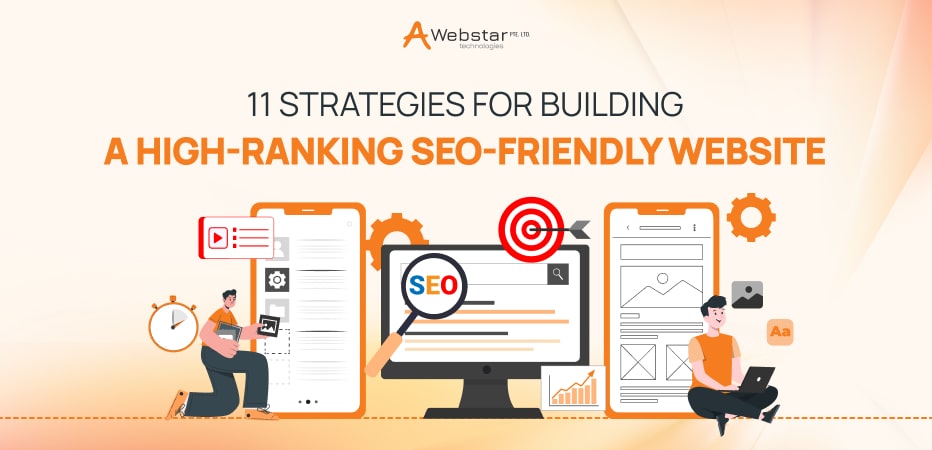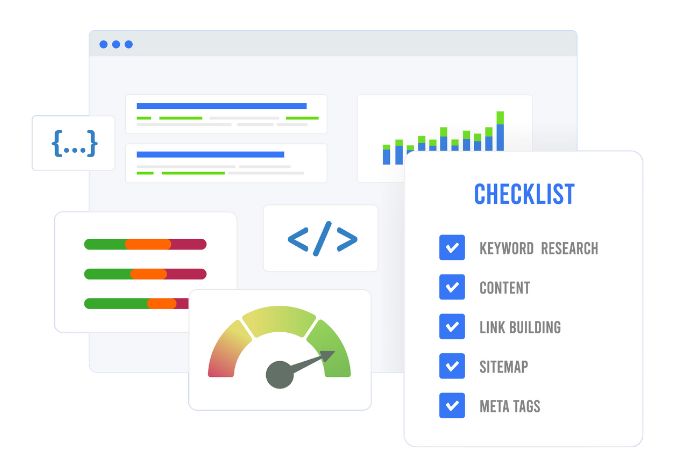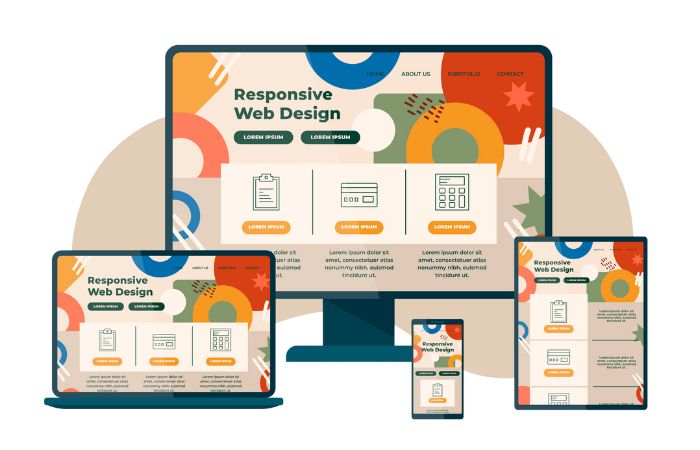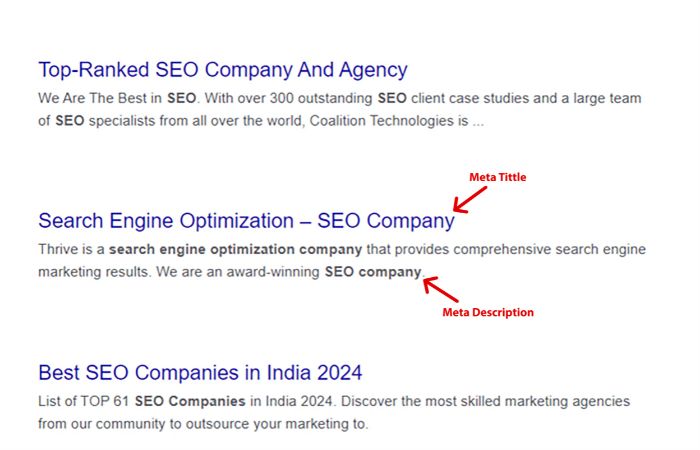
In the current digital era, it is essential to own a website that ranks high on search engines for visibility & better outcomes. Studies have found that 75% of users never go past the initial page of search results. Websites displayed on top are getting 92% of all search traffic from Google.
This blog post will discuss various strategies you can use to build an SEO-friendly site to help attract more visitors. It will also help improve their experience. Now, let us dig into the process of making your site fully ready for the best search engine rankings.
Why Having an SEO-Friendly Website Is Important

Implementation of SEO strategies at the start of a website results in the following beneficial outcomes:
Enhancing Credibility
Your website stands a better chance of ranking higher in search results that position your brand. Users usually trust and engage more with top-ranking search results, which increases your brand’s reputation.
Improved User Experience
An SEO friendly website Design that is easy to navigate has fast loading times, and is mobile responsive enhances user satisfaction. It can lead to more extended visits and reduced bounce rates.
Cost Efficiency
search engine optimisation offers a cost-effective approach to driving organic traffic compared to traditional advertising methods. It is relevant to optimise your website for relevant keywords and provide valuable content. Thus, you reduce dependency on paid ads and save on marketing expenses in the long term.
Increased Traffic and Engagement
search engine optimisation efforts aim to improve your website’s visibility in search engine results pages. These efforts help potentially drive more organic traffic. Research indicates that the top results in Google capture approximately 32% of clicks. Top SEO companies in Singapore know the importance of ranking and generating website visits and engagements well.
How to Build a Friendly Website

The creation of an SEO-friendly website requires constant work. This is due to frequent algorithm updates. Furthermore, it needs some time to improve your rankings. Here, we will look at different methods to help you take the first step in getting your website to appear at the top of search results.
Create Website Content to Target Valuable Keywords
Just by writing content that is friendly for search engine optimisation, you can improve the position of your website in search engine result pages. It is necessary to include keywords related to your products and services while creating a blog post. You must get them by conducting keyword research. Search for your main keyword in the search engine and find other related terms in the results.
Various tools like Google Trends and Ahrefs help you understand popular topics and the purpose of the audience’s search. So, once you can find your targeted keywords, apply them naturally and strategically. Also, avoid including these keywords in content without considering their context and readability. It may negatively impact user experience and reduce your chance of appearing on the top of SERPs.
Make Use of Header Tags
The optimisation of header tags is very beneficial for making a website SEO-friendly. The beginning of a particular section in content should have a header tag. The title of this page is an H1 tag, whereas the subheadings are tagged as H2, H3, and so on. You must include the most relevant keywords in them organically.
Subsequently, the title of your content must have a primary keyword. Search engine crawlers get the context of your content and index the page accordingly. It also helps increase your ranking for the particular keyword used in titles and subheadings.
Clean URL Structure
An SEO-friendly URL should be easy to read, simple to understand, and relevant to the page’s content. This helps both users and search engines assess the quality of your page.
Avoid long query strings with numbers, as they can be hard to read and less effective for SEO. Using SEO-friendly URLs will improve your website’s visibility to search engines and boost your site’s ranking in relevant search results.
Mobile Responsiveness

Creating a website that is friendly for mobile devices plays a significant role in making an SEO-friendly website. Search engines like Google regard how well a website functions on mobiles as an essential criterion for ranking search results.
Hence, your website should be able to load quickly on mobile devices. It is necessary to ensure that your website’s design is responsive. It means it must adjust to different screen sizes. Most ready-to-use themes for WordPress or other website platforms come with a mobile version. Consequently, do not forget to use tools like Google’s Mobile-Friendly Test to check if your site is up to the current standards.
Ensure Your Web Pages Load Fast

Search engines prioritise websites that load quickly and provide an optimal user experience. A slow website reduces customer satisfaction, hurts your SEO effort, and makes it harder for search engines to crawl your content. You must optimise HTTP requests to reduce server response time.
Also, compress images and other media files to reduce size while maintaining quality. Always try to opt for a better web hosting plan with higher bandwidth. Using a content delivery network(CDN) to distribute a load of hosting images, videos, and other static content across multiple servers worldwide makes a difference.
Image Optimisation

To make your images SEO-friendly, follow these image optimization steps to enhance your website’s appearance in search engines:
- Add ALT Tags: Always add descriptive ALT tags to your images. These tags should include keywords and accurately describe the image. ALT tags help search engines understand the content of your images and improve accessibility for users with visual impairments.
- Optimise Image Size: Make your images smaller in size before uploading them to your website. Images with larger file sizes can slow down your page, negatively impacting your SEO performance. Compress your images to reduce their size while maintaining quality. Ensure the image size is less than 100 KB for optimal performance.
Organise and Clean Up the Site Code
Your website involves numerous lines of code that are responsible for running various functions. These lines of code may become unorganised and hinder one another as you grow your website. It is recommended that they be cleaned up when necessary to prevent this.
This process also helps the search engine indexing process and makes your site load faster. All these factors highly affect your website’s SEO performance. Website code covers different types of programming languages. These are HTML, CSS, and Javascript. Each of these languages is organised uniquely.
Internal Links

Internal linking is connecting pages of your website to and from one another. It is an integral part of your site’s structure, along with the website’s navigation menu. They are a critical part of the user experience that provides users with a clear path for finding all the answers.
Using these internal links, it becomes easy for visitors to come across relevant content as they browse. Hence, internal linking signifies to Google your site’s most popular and influential pages. It is necessary to ensure that each page on your site has at least one internal link. This link can be design-oriented. You can use decorative buttons, images, and triggered animations to engage users.
Use Google Tools
Website owners get the information to analyse its core metrics through various analytical tools. These include Google Search Console and Google Analytics. These tools are crucial for tracking performance and understanding how to submit your website to search engines properly.
This process ensures search engines recognise and appropriately index your site, improving its visibility in search results. Many free tools like Google Search Console help website owners check the performance of their sites in Google Search Results.
Use Images and Videos to Enhance the Content

Visual elements such as pictures and videos can enhance the attractiveness of your content. Some visuals, like graphs and charts, are also helpful for displaying data more clearly or conveying messages better. Putting in pictures and videos can also enhance the SEO-friendliness of your content. If you have media files, they can be shown on Google search results under the image and video tab, which raises the possibility that viewers will click on them.
Your content might show up as a rich snippet. It will display more details and is more probable to be shown at the beginning of search outcomes. Remember to include optimised images and videos. The optimisation process for photos and videos includes reducing their size through compression and adding the correct alt text.
Optimise the Title Tags and Meta Descriptions

A title tag appears on the search engine result as a clickable headline. Meta description offers short snippets about what readers expect to find on the page. Ensure that a title tag includes the content’s focus keyword. Also, it must align with the target audience’s search intent. It helps your content appear on the right search results.
It is necessary to keep your title tag between 50-60 characters. A meta description provides more space to introduce the content to potential readers. Google SERPs only display 150-160 characters, so these descriptions must be unique. They must provide relevant information for your target audience.
Create an SEO-Friendly Website Today
In summary, these strategies will significantly boost your website’s search engine optimisation performance, ensuring higher rankings and increased visibility. For expert SEO services, turn to Awebstar Technologies. We’ll transform your website into an SEO powerhouse, keeping you ahead of the competition. Contact us online or call +65 6909 9163 to speak with an expert about our SEO services.
Make Estimating SEO Services Costs Easy with Awebstar
Determining the cost of SEO services can be challenging. Get a quick estimate for your SEO services with our free quotes.
















































